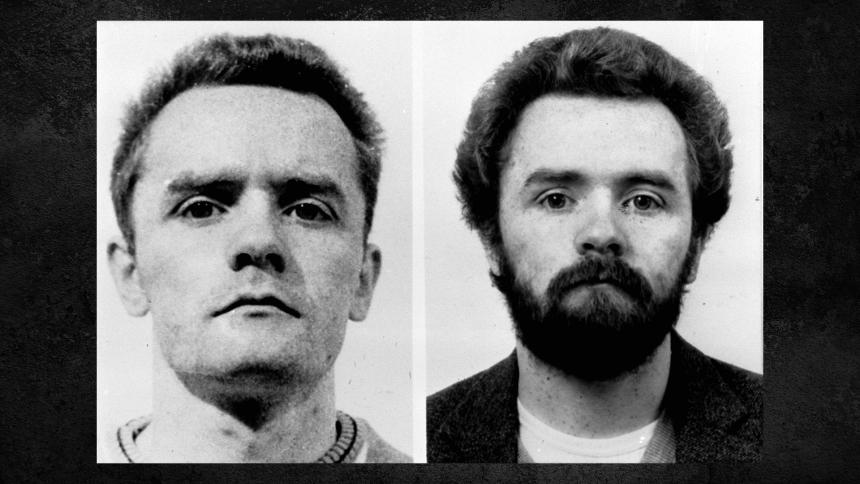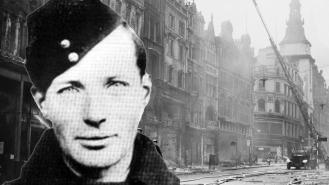
The railway rapists
Even today it is rare to find serial rapists and killers working as couples reinforcing each other’s depraved desires and urges. This rare bonding of two twisted psyches stimulating and encouraging each other towards sadistic actions is what made the violent raping and eventually three times killing spree of John Duffy and David Mulcahy aka ‘The Railway Rapists’ in the late 80’s so chilling.
An added twist to the shocking story of the murderous life-long friends who attacked countless victims near railway stations is that it took ten years after the arrest of Duffy for the truth to be revealed. The duo’s attacks, involving up to forty brutal rapes and three sadistic murders instigated the first scientific offender profiling to try to catch the killers while DNA technology was tragically some years off from identifying the maniacs before they had ruined so many lives.
Disturbing school pastimes
Just by chance, a reclusive teenage John Duffy met his equally twisted soul-mate, David Mulcahy, at Haverstock Secondary school, Chalk Farm in north London in what was to become an inseparable friendship that would later fuel dark sexual fantasies. A former student described how Duffy was a ‘loner’ walking around in a duffel jacket with the hood up keeping himself to himself and who was bullied mercilessly by other bigger boys. Due to his small size and acne flawed skin, Duffy became the archetypal bullied schoolboy who refrained from interacting socially. By chance, Duffy met the equally disconnected Mulcahy at school where they soon shared a sadistic streak for tormenting animals.
Although this meeting of degenerate minds may have been rewarding for these two would-be rapists and murderers, their growing adult relationship of unconditional loyalty and mutual trust was to seal the horrific fates of their many victims in years to come.
Mulcahy, noted by psychologists as having been the more violent of the pair, displayed early signs of his cruelty when as a young teenager at school he was discovered inflicting pain on a hedgehog using it as a cricket ball, battering it so badly it died. This brutal behaviour, lacking empathy for a creature’s suffering at such a young age is a trait often associated with adult murderers who progress from killing animals to people. In this case, the theory was proven right when Duffy and Mulcahy transferred their sadistic intentions from defenceless animals to women.
Sinister bond
Before Duffy and Mulcahy left school they had sworn a pledge that they would never 'grass' on each other. It was a prophetic promise that would be kept to the letter even when one of them was arrested and incarcerated while the other remained free. As the teenage misfits got older their increasing interest in terrorising people began with an insidious game on Hampstead Heath where they would jump out on courting couples and individuals late at night, deriving pleasure out of frightening people out of their wits. Duffy also developed a keen interest in the army and martial arts where he shared his interest in learning about kidnapping techniques and holding people hostage with Mulcahy.
After leaving school the inseparable duo’s disturbing antics seemed to be forgotten and resigned to the past. They both married within a year of each other in 1977 and 1978 and took up steady work. Mulcahy trained as a plasterer and Duffy became a carpenter who worked for a variety of employers including British Rail. It was through the latter company that Duffy was able to arm himself with knowledge of the rail network to carry out violent assaults on women either around or near deserted railway stations.
Serial rapists
The first vicious rape by Duffy and Mulcahy as a partnership of terror took place in Kilburn, North London in 1982. The 22-year-old victim was walking late at night from a party carrying a teddy bear when she was abducted and dragged to a shed where she was stripped, blindfolded and raped. The former schoolboys, who had shared a passion for cruelty and enjoyed inflicting trauma on strangers had now become rapists who acted together to sate their sadistic urges. The horrific attack on the young woman in Kilburn was the start of a four-year campaign of terror carried out by the pathologically disturbed duo. Eighteen known rape victims were seized over a twelve month period often around deserted railway stations including Hampstead Station near Hampstead village. While the rapes stopped briefly during 1983 - later believed to be due to Duffy’s separation from his wife – the police still had no evidence to link the crimes. The rapes commenced again in 1984 and in 1985 three women were raped on the same night in the Hampstead and Hendon areas of north London prompting the police to set up ‘Operation Hart’ in what was later to become the largest investigation since the search for the Yorkshire Ripper in the late 70s.
Another psychologist described Duffy and Mulcahy’s behaviour like ‘two teenage men going out on the pull’
John Duffy’s obsession with sexual violence was satisfied by the act of rape but it was Mulcahy, whose sadistic desires to inflict maximum terror, would – as the police feared – eventually lead to murder. The press at this stage referred to the attacks as committed by ‘The Railway Rapist’ unaware or without conclusive knowledge that there was an accomplice. Likewise, the police were uncertain as to whether they were dealing with one attacker or two.
Sadistic teamwork
The confidence that Duffy and Mulcahy derived from their raping spree came from working as a team where each reinforced each other’s behaviour. One would act as ‘lookout’ while the other would rape. So cruel and vicious were the attackers in their treatment of their victims they even tossed a coin to agree on who would rape first. For the sadistic duo, such attacks were simply ‘sport’ or ‘hunting’ as Mulcahy himself described after his arrest, demonstrating how the two young men had ‘normalised’ their behaviour. As Duffy and Mulcahy developed feelings of invincibility they would target specific areas looking for victims. Having broken into a car and stolen a Michael Jackson ‘Thriller’ tape they would constantly play it while driving around to psyche themselves up.
While they were carrying out their horrendous attacks on lone women they were, in fact, living double lives at home as ‘normal’ family men. Duffy had one child while Mulcahy, who was possibly the leader of the two and with greater violent tendencies, was a father of four. A list of 1800 sex offenders as potential suspects compiled by the police had Duffy down for investigation as part of Operation Hart due to his previous run-in with the law over the sexual assault of his wife. But victims of the rapes carried out by the two men failed to point Duffy out in ID parades, possibly due to the women being terrified. Mulcahy was also questioned by police and eventually released.
Motivation for rape
Prison psychologist Dr Jenny Cutler believed that certain elements of the duo’s partnership in violence reinforced their addiction. 'They both found offending very exciting. Rape took that to another level. The hunt, the working as a team, having contingencies for how they were going to operate and the outwitting of the police, all contributed to the excitement'.
Dr Cutler who was to later interview Duffy as his psychologist described how the twisted pair came to think about assaulting women in the first place. 'John Duffy's wife was away one weekend. They discussed details such as disorientating the victim and holding hostage for an entire weekend'.
Another psychologist described Duffy and Mulcahy’s behaviour like ‘two teenage men going out on the pull’. The disturbing reality being that working together in tandem, reinforcing each other's sadistic desires helped make them believe what they were doing was trivial. Raping as a pair led to an escalation of violence due to the shared belief of invulnerability in what could be described as a twisted co-dependent relationship. Dr Cutler recognised two distinct MOs in the pair’s motivations to attack women. 'They had different reasons for committing rape. Duffy was aroused by the idea of rape. While Mulcahy's bent was violence. It was Mulcahy's unsated urges which led the pair to kill'.
From rape to murder
Alison Day was just 19 when she was abducted, raped and murdered on the cold dark evening of December 29th 1985. Day was making her way to meet her boyfriend at his place of work at Fairway Graphics in north London at a desolate trading estate close to Hackney Wick station. Having stopped at a telephone box en route after leaving the station it is believed she took a wrong turn heading down to the canal and into the path of Duffy and Mulcahy who were waiting. During the terrifying attack Mulcahy made a mistake by calling out Duffy’s name. Dr Cutler believes he may have done this on purpose as an excuse to justify murder. 'It gave Mulcahy permission to take it to that next step and for Duffy to prove himself to Mulcahy that he didn’t have a conscience'.
Day was brutally strangled with a tourniquet and dumped in the river Lea. Her coat was weighed down with discarded granite cobbles placed in its pockets in an attempt to submerge the body permanently. It was the first murder by Duffy and Mulcahy which was to demonstrate the fiends’ trademark of their killing spree where rape was soon followed by strangulation using a rope and tourniquet. In some cases a sock was used to stuff down the victim’s throat. Alison Day’s cruel, cowardly murder presented a tightening of the toxic bond between the two sadists.
Second murder
The affluent, leafy community of Horsley in Surrey was to be the next horrifying scene of murder on the 17 April 1986. This time the victim was 15-year-old Dutch schoolgirl Maartje Tamboezer who had set off from home in the late afternoon on her cycle to buy sweets. Whether Duffy and Mulcahy had seen Tamboezer earlier or happened to spot her cycling in their direction the debauched killers laid a trap by fastening a piece of string across the lane where they lay in wait.
Seeing the string and possibly dismounting her bike to remove it, Maartje was violently abducted. The schoolgirl must have been terrified as she was dragged some distance through the surrounding wood to a secluded place where she was raped in turns by Duffy and Mulcahy before being strangled using the same technique that had killed Alison Day. The cruel killers then tried to destroy evidence of their evil crime by burning Maartje’s body.
Clues
Attempting to burn evidence of their evil handiwork the murderers had carelessly left vital clues in the form of the string and discarded matches. The string the killers used both to block the footpath and tie their young victim was of a rare kind known as ‘somyarn’ which Duffy carried with him and also kept at his parent’s house. Forensics began to analyse the string and an investigation into its source and manufacture would later prove crucial at trial. But the discovery of the innocent teenager’s abused and charred body shocked and distressed the most hardened of police officers at the scene. The need for apprehending the perpetrators of such a brutal assault on a child was now a matter of urgency prompting Surrey police to set up Operation Bluebell.
Profiles
The case of the Railway serial rapists was one of the first in British police history to employ experts to build a profile picture of the unknown attacker, still believed to be a lone offender. Professor David Canter, an eminent behavioural scientist, provided the police with a psychological profile of the murderer. Out of 17 points that he came up with, 13 of them matched perfectly with John Duffy. Although Duffy, a known sex offender due to his previous assault on his wife, he had avoided arrest due to the fact that many witnesses either refused to take part in ID parades out of fear or failed to pick him out. One unsettling aspect of Duffy’s physical appearance was what was described later by some victims as Duffy possessing ‘laser eyes’ which had a tendency to stare in the most disturbing manner.
Like Duffy, his psychopathic accomplice Mulcahy was able to maintain a double life appearing to outsiders and neighbours that he was an ordinary friendly guy. In fact during the period of brutal rapes that he and Duffy were carrying out Mulcahy became fanatical about roller skating, taking up his hobby in Battersea Park where he made friends with fellow enthusiasts. What no-one could suspect was that this family man who some neighbours said ‘would do anything for you’ - would also rape their daughters or wives given the chance.
Final murder
A month later on the 18 May 1986, Duffy and Mulcahy were to carry out their last frenzied attack near another railway station at Brookmans Park in Hertfordshire. Anne Lock, a recently married 29-year-old secretary for London Weekend Television was alighting at the station when she was targeted by the killer duo. They had spotted Lock’s parked bike at the station earlier and suspecting it belonged to a female decided to lay in wait for their defenceless prey. Spotting Mrs Lock alighting and collecting her bike, they followed their victim. Anne’s sexually abused and strangled body was found six weeks later in a field. This third murder heralded the first multi-police force murder enquiry (Operation Trinity) since the badly executed Yorkshire Ripper enquiry. It was the first such investigation to utilise basic computers and an early version of HOLMES (Home Office Large Major Enquiry System).
Duffy himself, due to a previous claim of rape by his wife was on a police register of possible suspects given the codename Z Men. After having been interrogated by the police and claiming he couldn’t remember anything about his movements due to having been mugged and beaten, Duffy was released. As part of a cunning tactic to prevent further questioning or an appearance in court Duffy took himself to hospital claiming he had been mugged and was suffering from amnesia. His tactic went one step further when he pressurised a friend to fake an attack on him and inflict real injuries. What Duffy didn’t know at the time was that he had been put under police surveillance. Once he suspected he was being tailed by plain clothed detectives he played a cat and mouse game with officers, running away when least expected. But his big mistake, due to uncontrollable sexual urges and a pathological belief in his own invincibility was that he continued to attack women on his own without Mulcahy. While stalking a woman in a quiet park with the intention to rape, he was arrested. The police now had just 36 hours in which to collect hard evidence to present to a magistrate in order to detain Duffy.
Duffy's violent sexual fantasies disclosed
Duffy’s wife was brought in for questioning who nervously informed investigating officers how she would come home to find her husband watching violent martial arts videos. More tellingly she described his sexual behaviour with her which involved him tying her up and forcing her to have sex. More shockingly she revealed during the interview that Duffy had once claimed he had raped a girl telling his disbelieving wife ‘I raped a girl tonight and it was all your fault’.
Demonstrating a talent for imaginative lying during questioning by the police Duffy was arrogantly confident that he would be freed within hours. His psychotic ‘laser’ stare was one ingrained image that terrified victims remembered and the reason why some could not bear to confront again in a face to face ID parade. Despite many failing to identify him five girls did eventually pick him out. All the time as the walls were closing in on Duffy he remained silent about his accomplice in rape and murder, one David Mulcahy, who was still free at large and had by now resumed his ‘ordinary family life’.
Forensic evidence and charges
Duffy and Mulcahy had like most killers left a small but distinctive trail of evidence at each crime, one piece, in particular, being the use of a stick used as a tourniquet to strangle their victims. More vital was the unique strand of string ‘somyarn’ in the case of murdered Dutch teenager Maartje Tamboezer and several matchsticks and burnt tissues after the killers had attempted to burn her body. It was these items including a series of knives used during the abductions that were found at Duffy’s home including reading material such as The Anarchist’s Cookbook which detailed the kind of martial arts and hostage techniques used by Duffy.
At Duffy’s parents’ house investigating officers found the one crucial piece of evidence linked to the murdered Dutch girl, a ball of the unique 'somyarn' string used to tie up the terrified victim.
Arrest and conviction
Evidence for the Tamboezer schoolgirl murder and five rapes against Duffy was overwhelming but not for the remaining two murders of Alison Day and Anne Lock which were difficult to prove due to the lack of forensic evidence. Day’s body had been submerged in a canal for days meaning that any scrap of forensic evidence had to come from the Lab. A breakthrough finally came after seventy items of clothing from Duffy were bagged and analysed and the Lab discovered fibres that also came from Day’s clothing. However, the evidence was weak and detectives assumed the worst in convicting Duffy for Day’s murder. But a few weeks before the trial more results came through from forensics revealing thirteen separate positive identifications of fibre found on Day from the clothing of Duffy. Those fibres were the significant piece of evidence which was virtually a fingerprint.
Duffy’s amnesia ruse was soon destroyed when his colleague revealed to the police that Duffy had told him that he was being framed by the police and that he wanted help to fake a violent mugging. ‘He even wanted me to slash him with a razor’ admitted the colleague. ‘He kept on at me to help him. He was so insistent he scared me’.
At his trial in February 1988, John Duffy was found guilty of four rapes and the murders of Alison Day and teenager Maartje Tamboezer but not of the television secretary Anne Lock. The judge recommended he should serve a minimum of thirty years. Even after knowing he was unlikely to receive parole before his three-decade sentence, Duffy offered no hint of having an accomplice. Mulcahy was still free to rape and murder.
Fugitive killer's arrest
For nearly ten years in Whitemoor prison, Duffy remained silent about his close lifelong friend and accomplice having been involved in the violent rapes and murders during the 80s. Mulcahy had actually stopped attacking women soon after Duffy’s arrest and incarceration, possibly because he needed Duffy as support. But in 1997 the secret that Duffy kept close to his chest due to a schoolboy pact made over twenty years before was finally revealed during a conversation with Dr Jenny Cutler.
The psychologist who was seeing Duffy due to his recurring nightmares was unprepared for the prisoner’s casual confession as he let slip that he had not carried out the attacks alone. Dr Cutler innocently enquired which prison the accomplice was remanded in when Duffy dropped the bombshell that his co-rapist and murderer had never been arrested or convicted. Dr Cutler reported back to the authorities and the police officers who had been involved in the case a decade before.
Broken pledge
The schoolboy bond made between Duffy and Mulcahy in the late 70s had finally broken down after nine years in prison in which Duffy had never heard or seen anything of Mulcahy since the day of his arrest. Now in 1997 advanced forensics and DNA technology were able to scrutinise material relating to the earlier crimes of the two killers. David Mulcahy was finally convicted and found guilty on the 2nd February 2001 at the Old Bailey of five rapes, five conspiracies to rape and three murders, receiving three life sentences. Duffy received an extra twelve years due to the new evidence.
The psychopathic father of four who had cockily maintained his innocence in court and claimed that he had been framed by Duffy failed to convince a jury that he was a victim of circumstances and revenge. Mulcahy’s days of freedom, so many years after committing countless rapes and three brutal murders had finally come to an end due to the persistence of the police and what Dr Cutler believed appeared to be a change in Duffy’s personality. 'He seemed to want to get it off his conscience and also to make sure that Mulcahy couldn’t commit future killings. He got in touch with a more empathetic side to him'.










